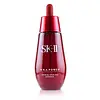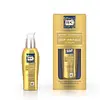What's inside
What's inside
 Key Ingredients
Key Ingredients

 Benefits
Benefits

 Concerns
Concerns

 Ingredients Side-by-side
Ingredients Side-by-side

Water
Skin ConditioningButylene Glycol
HumectantGlycerin
HumectantGalactomyces Ferment Filtrate
HumectantNiacinamide
SmoothingPentylene Glycol
Skin ConditioningPhytosteryl/Octyldodecyl Lauroyl Glutamate
Skin ConditioningIsopropyl Isostearate
EmollientDimethicone
EmollientSqualane
EmollientXylitol
HumectantVinyl Dimethicone/Methicone Silsesquioxane Crosspolymer
Boron Nitride
AbsorbentPanthenol
Skin ConditioningPEG-20 Sorbitan Cocoate
EmulsifyingTocopheryl Acetate
AntioxidantDimethicone/Vinyl Dimethicone Crosspolymer
Skin ConditioningPhenoxyethanol
PreservativeBenzyl Alcohol
PerfumingAcrylates/C10-30 Alkyl Acrylate Crosspolymer
Emulsion StabilisingDipentaerythrityl Tri-Polyhydroxystearate
EmollientPEG-11 Methyl Ether Dimethicone
EmulsifyingAminomethyl Propanol
BufferingCeratonia Siliqua Fruit Extract
MaskingLaureth-7
EmulsifyingMethylparaben
PreservativePolymethylsilsesquioxane
Sodium PEG-7 Olive Oil Carboxylate
EmulsifyingXanthan Gum
EmulsifyingDisodium EDTA
PEG-100 Stearate
PEG-7 Glyceryl Cocoate
EmulsifyingAcanthopanax Senticosus Root Extract
Skin ConditioningParfum
MaskingEthylhexylglycerin
Skin ConditioningHydrolyzed Soy Protein
HumectantCynara Scolymus Leaf Extract
Skin ConditioningPolyquaternium-7
Hydrolyzed Yeast Protein
Skin ConditioningPalmitoyl Pentapeptide-4
Skin ConditioningMethylsilanol Tri-PEG-8 Glyceryl Cocoate
EmulsifyingMethicone
EmollientCI 77891
Cosmetic ColorantCI 77492
Cosmetic ColorantWater, Butylene Glycol, Glycerin, Galactomyces Ferment Filtrate, Niacinamide, Pentylene Glycol, Phytosteryl/Octyldodecyl Lauroyl Glutamate, Isopropyl Isostearate, Dimethicone, Squalane, Xylitol, Vinyl Dimethicone/Methicone Silsesquioxane Crosspolymer, Boron Nitride, Panthenol, PEG-20 Sorbitan Cocoate, Tocopheryl Acetate, Dimethicone/Vinyl Dimethicone Crosspolymer, Phenoxyethanol, Benzyl Alcohol, Acrylates/C10-30 Alkyl Acrylate Crosspolymer, Dipentaerythrityl Tri-Polyhydroxystearate, PEG-11 Methyl Ether Dimethicone, Aminomethyl Propanol, Ceratonia Siliqua Fruit Extract, Laureth-7, Methylparaben, Polymethylsilsesquioxane, Sodium PEG-7 Olive Oil Carboxylate, Xanthan Gum, Disodium EDTA, PEG-100 Stearate, PEG-7 Glyceryl Cocoate, Acanthopanax Senticosus Root Extract, Parfum, Ethylhexylglycerin, Hydrolyzed Soy Protein, Cynara Scolymus Leaf Extract, Polyquaternium-7, Hydrolyzed Yeast Protein, Palmitoyl Pentapeptide-4, Methylsilanol Tri-PEG-8 Glyceryl Cocoate, Methicone, CI 77891, CI 77492
Water
Skin ConditioningCyclopentasiloxane
EmollientGlycerin
HumectantTetrahydroxypropyl Ethylenediamine
Dimethicone Crosspolymer
Emulsion StabilisingDimethicone
EmollientAmmonium Acryloyldimethyltaurate/Vp Copolymer
Nylon-12
PEG-12 Dimethicone
Skin ConditioningTocopherol
AntioxidantPhenoxyethanol
PreservativeCitric Acid
BufferingButylene Glycol
HumectantPentylene Glycol
Skin ConditioningLaureth-23
CleansingHydrolyzed Wheat Protein
Skin ConditioningParfum
MaskingLaureth-4
EmulsifyingMethylparaben
PreservativePropylparaben
PreservativeDisodium EDTA
Alanine
MaskingBHT
AntioxidantHelianthus Annuus Seed Oil
EmollientC13-14 Isoparaffin
EmollientPolysorbate 20
EmulsifyingMagnesium Aspartate
Skin ConditioningZinc Gluconate
Skin ConditioningBisabolol
MaskingRetinol
Skin ConditioningAscorbic Acid
AntioxidantLaureth-7
EmulsifyingCopper Gluconate
Skin ConditioningCI 19140
Cosmetic ColorantWater, Cyclopentasiloxane, Glycerin, Tetrahydroxypropyl Ethylenediamine, Dimethicone Crosspolymer, Dimethicone, Ammonium Acryloyldimethyltaurate/Vp Copolymer, Nylon-12, PEG-12 Dimethicone, Tocopherol, Phenoxyethanol, Citric Acid, Butylene Glycol, Pentylene Glycol, Laureth-23, Hydrolyzed Wheat Protein, Parfum, Laureth-4, Methylparaben, Propylparaben, Disodium EDTA, Alanine, BHT, Helianthus Annuus Seed Oil, C13-14 Isoparaffin, Polysorbate 20, Magnesium Aspartate, Zinc Gluconate, Bisabolol, Retinol, Ascorbic Acid, Laureth-7, Copper Gluconate, CI 19140
 Reviews
Reviews

Ingredients Explained
These ingredients are found in both products.
Ingredients higher up in an ingredient list are typically present in a larger amount.
Butylene Glycol (or BG) is used within cosmetic products for a few different reasons:
Overall, Butylene Glycol is a safe and well-rounded ingredient that works well with other ingredients.
Though this ingredient works well with most skin types, some people with sensitive skin may experience a reaction such as allergic rashes, closed comedones, or itchiness.
Learn more about Butylene GlycolDimethicone is a type of synthetic silicone created from natural materials such as quartz.
What it does:
Dimethicone comes in different viscosities:
Depending on the viscosity, dimethicone has different properties.
Ingredients lists don't always show which type is used, so we recommend reaching out to the brand if you have questions about the viscosity.
This ingredient is unlikely to cause irritation because it does not get absorbed into skin. However, people with silicone allergies should be careful about using this ingredient.
Note: Dimethicone may contribute to pilling. This is because it is not oil or water soluble, so pilling may occur when layered with products. When mixed with heavy oils in a formula, the outcome is also quite greasy.
Learn more about DimethiconeDisodium EDTA plays a role in making products more stable by aiding other preservatives.
It is a chelating agent, meaning it neutralizes metal ions that may be found in a product.
Disodium EDTA is a salt of edetic acid and is found to be safe in cosmetic ingredients.
Learn more about Disodium EDTAGlycerin is already naturally found in your skin. It helps moisturize and protect your skin.
A study from 2016 found glycerin to be more effective as a humectant than AHAs and hyaluronic acid.
As a humectant, it helps the skin stay hydrated by pulling moisture to your skin. The low molecular weight of glycerin allows it to pull moisture into the deeper layers of your skin.
Hydrated skin improves your skin barrier; Your skin barrier helps protect against irritants and bacteria.
Glycerin has also been found to have antimicrobial and antiviral properties. Due to these properties, glycerin is often used in wound and burn treatments.
In cosmetics, glycerin is usually derived from plants such as soybean or palm. However, it can also be sourced from animals, such as tallow or animal fat.
This ingredient is organic, colorless, odorless, and non-toxic.
Glycerin is the name for this ingredient in American English. British English uses Glycerol/Glycerine.
Learn more about GlycerinLaureth-7 is created by the ethoxylation of lauryl alcohol using ethylene oxide. Lauryl alcohol is a fatty alcohol with hydrating properties.
This ingredient is an emulsifier and cleansing ingredient. As an emulsifier, it is used to prevent ingredients from separating. It also helps cleanse the skin by gathering dirt, oil, and pollutants to be rinsed away.
Methylparaben is a preservative and is a paraben. It is used to prevent the growth of fungus, mold, and other harmful bacteria. Parabens are chemicals used as preservatives in both cosmetics and food.
Methylparaben can be synthetically created. It can also be found naturally in some fruits, such as blueberries.
Oftentimes, Methylparaben is combined with other parabens to help increase the shelf life.
The safety of Methylparaben is currently being studied. While ongoing studies are looking into the safety of parabens, the results have been very mixed. Some studies have not found Methylparaben to be harmful.
Learn more about MethylparabenParfum is a catch-all term for an ingredient or more that is used to give a scent to products.
Also called "fragrance", this ingredient can be a blend of hundreds of chemicals or plant oils. This means every product with "fragrance" or "parfum" in the ingredients list is a different mixture.
For instance, Habanolide is a proprietary trade name for a specific aroma chemical. When used as a fragrance ingredient in cosmetics, most aroma chemicals fall under the broad labeling category of “FRAGRANCE” or “PARFUM” according to EU and US regulations.
The term 'parfum' or 'fragrance' is not regulated in many countries. In many cases, it is up to the brand to define this term.
For instance, many brands choose to label themselves as "fragrance-free" because they are not using synthetic fragrances. However, their products may still contain ingredients such as essential oils that are considered a fragrance by INCI standards.
One example is Calendula flower extract. Calendula is an essential oil that still imparts a scent or 'fragrance'.
Depending on the blend, the ingredients in the mixture can cause allergies and sensitivities on the skin. Some ingredients that are known EU allergens include linalool and citronellol.
Parfum can also be used to mask or cover an unpleasant scent.
The bottom line is: not all fragrances/parfum/ingredients are created equally. If you are worried about fragrances, we recommend taking a closer look at an ingredient. And of course, we always recommend speaking with a professional.
Learn more about ParfumPentylene glycol is typically used within a product to thicken it. It also adds a smooth, soft, and moisturizing feel to the product. It is naturally found in plants such as sugar beets.
The hydrophilic trait of Pentylene Glycol makes it a humectant. As a humectant, Pentylene Glycol helps draw moisture from the air to your skin. This can help keep your skin hydrated.
This property also makes Pentylene Glycol a great texture enhancer. It can also help thicken or stabilize a product.
Pentylene Glycol also acts as a mild preservative and helps to keep a product microbe-free.
Some people may experience mild eye and skin irritation from Pentylene Glycol. We always recommend speaking with a professional about using this ingredient in your routine.
Pentylene Glycol has a low molecular weight and is part of the 1,2-glycol family.
Learn more about Pentylene GlycolPhenoxyethanol is a preservative that has germicide, antimicrobial, and aromatic properties. Studies show that phenoxyethanol can prevent microbial growth. By itself, it has a scent that is similar to that of a rose.
It's often used in formulations along with Caprylyl Glycol to preserve the shelf life of products.
Water. It's the most common cosmetic ingredient of all. You'll usually see it at the top of ingredient lists, meaning that it makes up the largest part of the product.
So why is it so popular? Water most often acts as a solvent - this means that it helps dissolve other ingredients into the formulation.
You'll also recognize water as that liquid we all need to stay alive. If you see this, drink a glass of water. Stay hydrated!
Learn more about Water